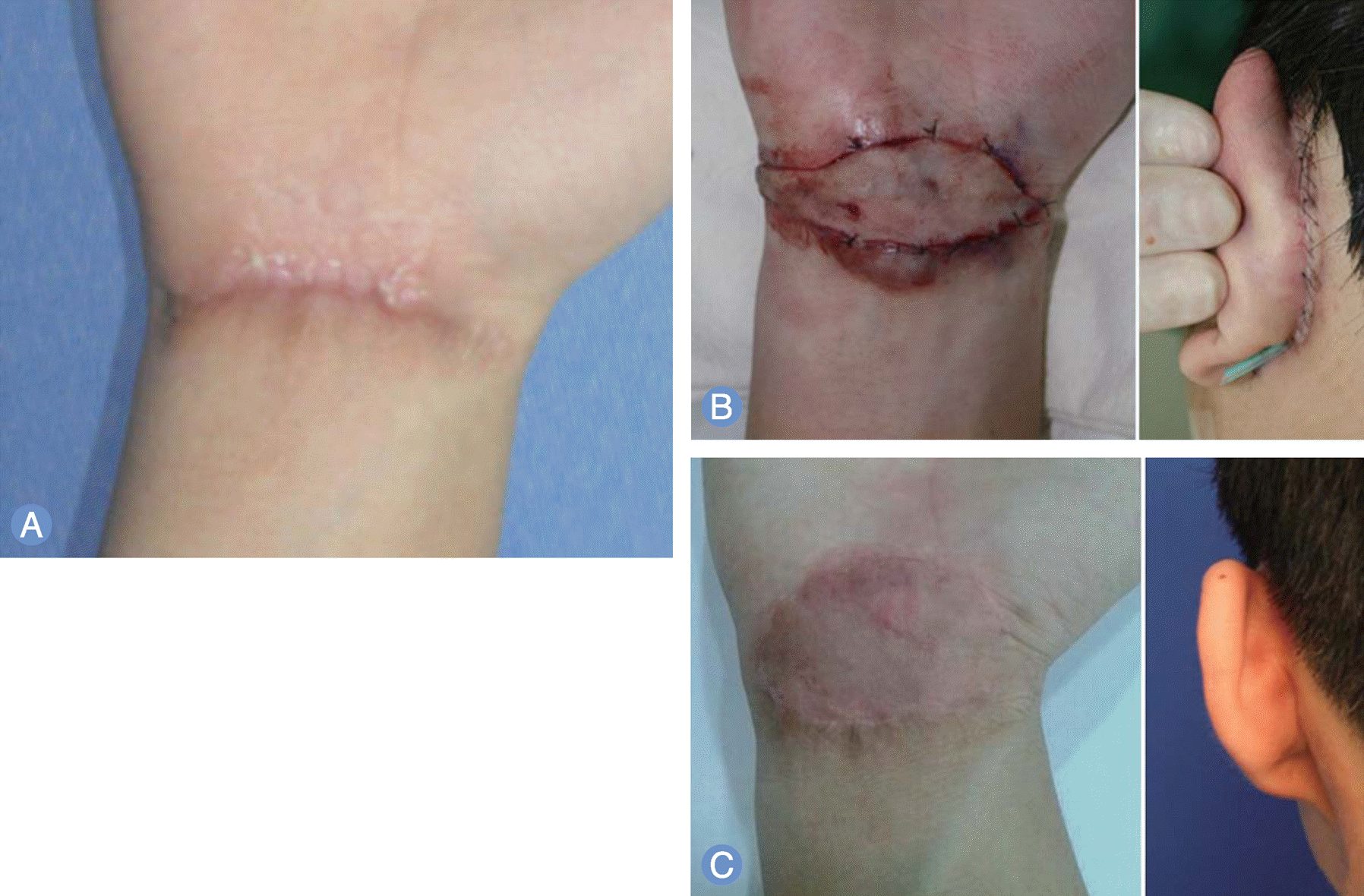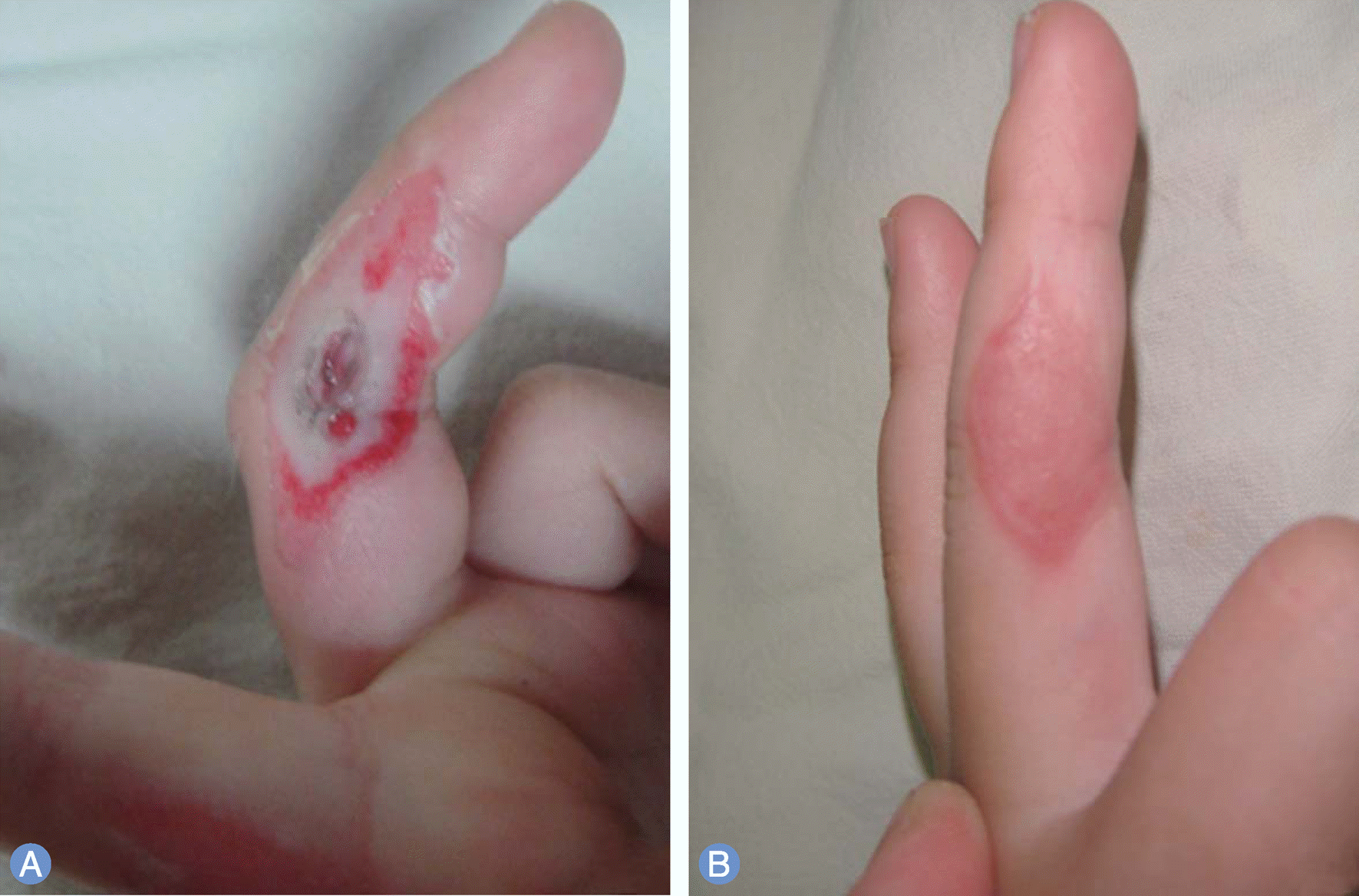Abstract
Purpose:
We used the retroauricular area skin as an alternative full-thickness skin donor site in the hand reconstruction surgery.
Methods:
From January 2006 to March 2013, 55 patients observed more than 1 year, were recruited for the study. In case of requiring the skin graft on hand, we grafted skins were harvested from the retroauricular area on hand. To assess the subjective and objective satisfaction, the patients themselves and three doctors compared the skin graft area's color with adjacent skin and estimated the donor site scar on a five-point scale.
Results:
A partial necrosis was seen in one case who received skin graft because of a burn scar contracture, but it was cured with conservative treatment. In other cases, the skin graft was well taken without any specific problems. The retroauricular skin graft showed good color match with adjacent skin and less pigmentation. Donor site scar was not noticeable. As a result, the patient's subjective satisfaction (4.07) and doctor's objective satisfaction (4.18) about skin graft were very good. And the patient's subjective satisfaction (4.93) and doctor's objective satisfaction (4.98) about donor site scar were also very good.
REFERENCES
1. Son DG, Park SC, Kim HJ. Medial side of the foot as a skin graft donor site for correction of burn scar contracture of the hand. J Korean Soc Surg Hand. 2005; 10:136–41.
2. Seo JW, Kwon H, Yim YM, Jung SN. Great toe pulp graft for the reconstruction of the postburn flexion contracture in the fingers. J Korean Soc Plast Reconstr Surg. 2007; 34:587–92.
3. Kim HH, Woo SH, Seul JH. Reconstruction of soft tissue hand defects using various skin free flaps from the foot. J Korean Soc Surg Hand. 1998; 3:237–48.
4. Avery CM, Iqbal M, Orr R, Hayter JP. Repair of radial free flap donor site by full-thickness skin graft from inner arm. Br J Oral Maxillofac Surg. 2005; 43:161–5.

5. Kim TB, Moe KS, Eisele DW, Orloff LA, Wang SJ. Full-thickness skin graft from the groin for coverage of the radial forearm free flap donor site. Am J Otolaryngol. 2007; 28:325–9.

8. Carlson JA, Grabowski R, Mu XC, Del Rosario A, Malfetano J, Slominski A. Possible mechanisms of hypopigmentation in lichen sclerosus. Am J Dermatopathol. 2002; 24:97–107.

9. Velangi SS, Rees JL. Why are scars pale? An immunohis-tochemical study indicating preservation of melanocyte number and function in surgical scars. Acta Derm Venereol. 2001; 81:326–8.
11. Webster JP. Skin grafts for hairless areas of the hands and feet; a preliminary report. Plast Reconstr Surg (1946). 1955; 15:83–101.
12. Menick FJ. Facial reconstruction with local and distant tissue: the interface of aesthetic and reconstructive surgery. Plast Reconstr Surg. 1998; 102:1424–33.

13. Christian EP, Jeffrey JP, Peter R. Skin graft. Mathes SJ, Hentz VR, editors. Plastic surgery. Philadelphia: WB Saunders;2006. p. 293–314.
Fig. 1.
(A) A 3-year-old boy who was born with syndactyly on third and fourth left finger. (B) Intraoperative finding shows 3.5 × 1.5 cm sized right retroauricular skin design to cover the third finger raw surface area. (C) Good color matching with surrounding tissues without any hyperpigmentation at 1 year after operation.

Fig. 2.
(A) 7 cm sized hypertrophic and scar contracture at left wrist. (B) Intra-operative finding shows grafting on right wrist with 7.0×2.5 cm sized skin harvesting on left retroauricular area and the donor site closed directly. (C) Postoperative finding at 18 months after surgery shows the correction of contracture and good color match with surrounding tissues without any hyperpigmentation. Moreover, donor site scar was obscure.

Fig. 3.
(A) 3.0 × 1.5 cm sized skin defect on third left finger. (B) Good color matching with surrounding tissues without any hyperpigmentation at 3 years after surgery.

Table 1.
Patients profile
| Characteristic | No. | Average graft size (cm2) | Graft take rate (%) |
|---|---|---|---|
| Congenital anomaly | 9 | 4.5 | 100 |
| Trauma | 25 | 11.3 | 100 |
| Scar contracture | 21 | 8.0 | 95 |
Table 2.
Result of the skin graft area
| Characteristic | Patient | Physicians* |
|---|---|---|
| Very well matching (5 point) | 9 | 15 |
| Well matching (4 point) | 42 | 35 |
| Moderate matching (3 point) | 3 | 5 |
| Poor matching (2 point) | 1 | 0 |
| Very poor matching (1 point) | 0 | 0 |
| Average | 4.07 | 4.18 |
Table 3.
Result of the donor site scar
| Characteristic | Patient | Physicians* |
|---|---|---|
| Very well state (5 point) | 53 | 54 |
| Well state (4 point) | 0 | 1 |
| Moderate state (3 point) | 2 | 0 |
| Poor state (2 point) | 0 | 0 |
| Very poor state (1 point) | 0 | 0 |
| Average | 4.93 | 4.98 |




 PDF
PDF ePub
ePub Citation
Citation Print
Print


 XML Download
XML Download